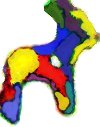
Transoxiana 13
Agosto 2008
Index 13
ISSN 1666-7050


|
Transoxiana 13  |
Institute of Archaeology, National Academy of Science of Kazakhstan,
Almaty, Kazakhstan.
azret_sultan[@]mail.ru
Russian State University for the Humanities, Moscow, Russia.
sergey_yatsenko[@]mail.ru
In the south of the modern Republic of Kazakhstan in the Middle Syrdarya valley between wide swampy and wooded flood lands of the great river and the Karatau Mountain range which is more than 2000 m high, parallel to it there is a chain of ancient oases partly extinct, which was connected with climate changing to worse and the land turning to desert at the end of the Middle Ages. In the pre-Islamic period they presented the north frontier of Transoxiana sedentary cultures, its original cultural periphery; up to the 2nd half of the third century AD these oases were the political centre of Kangha nomadic empire (Chin. Kang-kü/Kangju) and later on they remained the centre of a number of small political units after the state disintegration. The most important road of caravan trade passed via this group of oases; nowadays there are also international railway roads and highways there. The neighboring Karatau Mountains (presenting the western part of the huge T’ien Shan Mountain system) served an important source of different kinds of metals and stones (including precious ones) in Transoxiana.
The ancient sanctuary of Sidak (Sidak Ata tobe) is one of the most interesting monuments of this region (about the 1st c. BC – the middle of the 8th c. AD). It has been actively studied since 2001. It is located in 18 km to the north-west of the medieval city of Turkestan (ancient Yasy) in Turkestan oasis (the South Kazakhstan region, the Republic of Kazakhstan) in 1-2 km from railway and motorway roads. The remains of the city are visually detected among other surrounding objects of that kind due to the abundant inclusion of fire cinder. The main hill of the ancient fortress is rectangular-shaped (with rounded corners) with the total area of 340 x 150 m. The fortress had two entrances: one from the south, the other from the north-west (the latter presented a wide pandus) (Fig. 1). Around the ancient fortress there is a well-preserved moat formed by three natural riverbeds of the Asha-say coming from the north and the north-west from the Karatau Mountains. In ancient times it was a small but deep river which is nowadays dry except periods of spring rains. The fortress practically presented an island, being surrounded by water excluding the places of two entrances.
In the central part there is a horseshoe-shaped citadel of 14 m high. The entrance to it was situated in the south and presented a wide sloping pandus, probably with ill-preserved towers on its sides (Fig. 2). People coming up to the sanctuary on the top of the citadel ascended in clockwise direction moving along a circle way from the north-east entrance, which is rather interesting. The lower part of the fortress embraces the citadel from two sides (south and east ones), they present a typical kind of fortress – “two hills of different height” or “'tobe' hill with an adjusting ground” (the latter of 6-9 m high). But there is an additional “northern ground” structurally separated from the fortress (Fig. 1). Such layout is unusual for synchronic fortresses of the region, which allows us to consider Sidak an architectural complex of a special purpose. Together with the original character of the very first finds it led to including Sidak complex in the state-maintained three-year Kazakhstan’ program “Cultural Heritage” which has financed researching of the most important monuments of the country since 2001.
Sidak was discovered in 1947 by South Kazakhstan archaeological expedition (headed by A.N. Bernshtam), the unusual archaic looks of the materials from the fortress being evident even then (Bernshtam 1950, 82-83; fig.11, 3). A stratigraphical column of 16m width including 32 layers and five main construction periods was completed by Turkestan archaeological expedition in 1998-2000. Building structures of the ancient fortress are observed as deep down as the 17th layer with probability of a solid artificial platform beneath it (Tuyakbaev 2005, 494-502). Pottery which is in many respects traditional for an ancient fortress in the Syrdarya region beginning from the 1st c. BC was discovered in lower layers. All the constructions from the upper layer (the latest building period) – sanctuaries and dwellings – were destroyed in the flames of a big fire (the plaster on the sanctuaries walls was tempered as deep as 5sm). Bronze coins of the 1st half of the 8th c. were found in the layer of the fire site: a coin of Turgesh Turks with images of a lion walking to the right and a tamga-sign – premises 11, excavation trench II-3, 2005; a bronze Turkic-Sogdian coin with a rectangular hole, a tamga-sign and an inscription in Sogdian, type IV according to O.I. Smirnova which was minted beginning from 30-ies of the 8th c. (Smirnova 1981, 61, 400-401), a coin with the nishan-sign of Chorasmian local ruler Khusrau in Kerder, G-12 type which appeared at the turn of 7th - 8th cc. (Vainberg 1977,114-115; pl. XI); a Late Sasanian silver drahm of Khusrau II, coined in 621(a kind consultation of A.B. Nikitin). The fire led to a long-term devastation of the citadel. But evidently the fire did not surprise the dwellers as they had been able to take everything possible away from storerooms and dwellings just before the fire started.
As a fortress Sidak stopped its existence in the middle of the 8th c. It was a period of active Arabic invasions in Transoxiana. In 712-713 an anti-Arabic coalition of Western Turks, Sogdians, the rulers of Chach and Ferghana, was created (at that period Tashkent, Otrar and Turkestan oasis formed a political unity with the centre in Tarband near Otrar: Buryakov 1982, 123; Filanovitch 1983, 33). In response to it Kuteiba Ibn Muslim, an Arabic war leader, invaded Chach, devastated it but soon he started a revolt against the new khaliph and in the course of it fell in battle. A buried treasure of Arabic dirhems (the latest being dated back to 739) (Flanovitch 1983, 33-34) was found in the ruins of Aktepa of Yunusabad fortress in Tashakent oasis. Judging from the fact that Arabs were assisted by Western Turks and Chach in Talas battle in 751, the region had just been annexed into the Arabic Khaliphat. Probably Sidak pagan sanctuary was burnt down by Arabs (just before that being left by its inhabitants) in about 740 (Smagulov 2004a, 103-113)1. As it is generally known, the Khaliphat rulers paid special attention to pagan temples destruction. After the fire only some premises were used for a short time then the territory of Sidak was finally abandoned.
The north-west corner of the citadel was dug out (excavation trench II). The peculiarities of its layout make it possible to suggest that on the whole the citadel represented (in the 3rd construction layer) a concentric circle with the outer diameter of 60 m which has not been excavated yet. There is a sacred complex consisting of sanctuaries 1and 2 (sections 1 and 14), specific storehouses (depositories) and dwellings found in the 1st and 2nd layers which correspond to later constructing periods. The preserved walls are of 0.5-1.2 m high. Clay formed in large blocks (pahsa) and large-sized adobes of 46 x 24 x 10sm were the main building materials. The architecture of the sanctuaries is characterized by arches, vaults and domes. Flat roofs of big premises were supported with wooden columns. It should be mentioned that two sanctuaries of two different types were discovered in neighboring Sidak. They differ in altar constructive features and its location: in the first sanctuary alter is at the wall with a niche above it and in the second sanctuary the half-oval-shaped one is in the middle of the premises.
Sanctuary 1 (section1). The unusual isolation and thickness of its walls emphasize its specific function. The premises was separated from neighboring constructions by a by-street of 2.8 m wide from the east (and, probably, from the south-west) and by the fortress wall from the north-west. The corners of the building looked on the four cardinal points. The sanctuary was situated on the slope of the citadel. The walls were made of large adobes of 45-52 x 26-25 x 10 sm and plastered together with clay mortar. The south-west and the north-east walls are in a better condition (with the thickness of 1.9-2.0 m and the maximum height of the best-preserved parts of 1,8 m). The unsystematic remains of the burnt roofing are represented by wooden beams of 15-20 sm thick, poles of 10 sm thick, boards of 15-20 sm wide and, probably, mats made of reed.
The entry to the sanctuary (of 1.4 m wide) from the by-street was made in the north-east wall; there were three scorched transverse half-section timbers of 20-30 sm wide (all wooden parts in the premises were burnt down or charred) and a lengthwise one. Apparently, the entry presented an arch (vault). Having come the passage of 1.9 m long visitors used to get into the spacious premises (8.2 - 6.8 m) in the centre of which there were two column bases (evidently wooden ones) to the both sides from the entrance. There were panels (100 x 120 sm) made of boards (20 sm wide) under the column bases (Smagulov, Tuyakbayev 2003)2. Opposite the entrance in the south-west wall there was a low (up to 17 sm high) altar which looked like a rectangular-shaped podium (1.1 x 0.7 m); in the wall above it there was a niche of 70 sm deep at the level of 25 sm above the floor; to the left from the alter there was an oval-shaped hollow with rounded walls coated with clay. Along the three other walls there was a mound-sufa; in the western corner there was a rectangular open hearth (unfortunately, preserved only partly – 0.4 m of its original height and its initial construction has not been defined). Three fragmented jars and a ceramic tube of 1.7 m long have been found in the soil filling the premises. The building burnt down and was desolated in ruins for some time, then the place was leveled and a new floor with a new hearth was constructed above it 1meter high above the previous layer.
Sanctuary 2 (section 14). It was situated among other buildings behind the street which went around sanctuary 1. It was square (4.8 x 4.9 m), its walls (the maximum height of the best preserved part is 1.6m) were made of large adobes and were 1.2 m wide. From the inside along the three walls there were mounds-sufa (0.5 m high and 1.15-1.13 m wide); their surfaces, as well as the surfaces of the walls, were coated with three layers of yellow plaster of the highest quality. On the floor in the centre of the premises there was a half-oval in a longitudinal section altar (1.25 x 1.15 m), 0.5 m high with a slightly curved surface coated with yellowish plaster. The altar had a unique detail in the middle part of its straight side. It was a sharpened from both ends cylinder-shaped projection of 50 sm long with cones up to 16 sm high at both ends3. In the middle of the alter there was a round cup-like hollow of 9-10sm in diameter, filled with cinder. A series of sanctuaries of such type in pre-Islamic Transoxiana is known in Sogd, Chorasmia, Chach and Ustrushana; they are usually discovered inside citadels and palaces (Gurevitch 1990, 67-89).
Probably, a round construction separated from sanctuary 1 by a corridor or a narrow by-street also had a ritual function. Its outer diameter was 8 m, its inner diameter was 4 m, the round wall of 2 m wide had a solid foundation of 1.5 m deep. There was a small open hearth made of three adobes placed edgewise in the middle on the floor. Cinder of some burnt herbs was discovered inside of it. Unfortunately, the building has not been preserved in a good condition as its floor was practically at the level of the modern surface of the ground. Nevertheless, we can suggest that it made a single complex with sanctuaries 1 and 2, and the by-street. Being a massive round tower the building rose above the other constructions of the temple complex, its floor was 1.6m higher than the floors of neighboring buildings.
To the north from this round construction (in the north part of excavation trench II adjacent to the citadel edge) in the upper layer there is a group of small cells made of large adobes of the highest quality. These premises cannot apparently be considered dwellings. They were public buildings constructed by local builders who marked adobes (according to the order of authorities) with signs-nishan making them with their fingers on wet clay4. There were no sufa usual for dwellings, no hearths no fire-places. Bottoms of large dug in vessels-hum were found in the floor in a number of places as well as fragments of pottery in the soil covering it. On the whole, these premises were used as repositories and outbuildings of sanctuaries. These buildings, as it has cleared up, were constructed on a thick layer of rubbish above solid walls (preserved up to 4 m high) of an earlier large cultic courtyard (building layers 2 and 3).
The ritual courtyard in a sacral complex in building layers 2and 3 was discovered at the level of 4.5 m deep from geodesic 0m. According to stratigraphical data the courtyard layer corresponds to an earlier chronological period than that of sanctuaries 1 and 2 which correspond to building layer 1. Later on the territory of the courtyard was heaped with construction remnants and rubbish. In the south-east corner there was an accumulation of at least 50 broken hums, probably thrown down from the walls of the courtyard. This layer served as a foundation for outbuildings in the later sacral complex. The courtyard (Fig. 2) is trapeze-shaped (25 x 36 m) was open from the east and has an arch-shaped base. In the north it borders on the citadel wall with small adjacent premises. The arch-shaped base of the trapeze (the north wall is 42 m long, the side walls are 24m long. The south wall (21m long) (Fig. 3) is the highest one (4.2 m) and forms angles of 120º with west and east walls. Such courtyard layout has no analogies in the architecture of Transoxiana. The walls of the courtyard are made of pahsa with adobe layers. They are 2.5 m thick and the maximum height of preserved walls is 4.2-4.5 m. There are vertical splits in the walls, earthquakes may have been the reason of them. The splits were coated with adobes (in all walls except the south-east corner). Inside the courtyard there were cultic sites with traces of bon-fires, meals, some awnings with a light carcass. It is too soon to come to the conclusion as far as the character of the citadel architecture is concerned since only the constructions to the south, west and south-west from the courtyard belonging to the upper building layer have been excavated so far.
The eastern wall (21 m long) subsided by 1.1m. There was a sufa 10m long and 1.2 m high (Fig. 4), there is a passage in the wall (4.5m from the end of the sufa. Close to the passage the wall is wider and presents a high (0.9 m) slanting plinth. The upper surface of the sufa and its slanting part were covered with fragments of dozens of large vessels-hum (some part of fragments fell down on the courtyard floor). The majority of clan signs–nishan/tamga known today in Sidak are found on the fragments (see below). In its widened part (0.6m from the passage) the wall has a hollow (0.4 m in diameter), it, probably, served as a slot for a vertical wooden pivot to fix a door. A fragment of a millstone was discovered on the bottom of the hollow. Some rooms were adjacent to the north edge of the trapeze-shaped courtyard (the citadel wall). A massive podium-sufa was adjacent to the central part of it; in front of it on the floor there are remnants of two hearths with borders of adobes, a base of a hand-brazier and round hollows (for posts supporting roofing) as if surrounding the place with the hearths.
The west part of the courtyard has only been investigated up to the floor level of the second building layer (depth 0 – 2.5-2.7 m). Outside the west wall made of pahsa there were large adjacent premises, apparently, not dwellings. On the whole, the courtyard has been investigated to the level of the third building layer. In the period of creating of this layer the was a big sufa in the south-east corner; in the central part of the north wall at the podium-sufa there was an “altar part”; to the right of it, adjacent to the outside wall of the fortress, there were some rooms with large dug in vessels (hum and humcha) in the floor.
The excavation of the next layer (the fourth building layer of Sidak) of the courtyard has already been started. Five premises (which, probably correspond to an earlier building period) to the south from the “altar part” of the cultic courtyard, at the north wall with the sufa are now being under investigation These are small rooms – humhona (with an average area about 9-10 m²). Single bones of human skeletons (ribs, long limb bones, vertebrae and a big fragment of a skull – in one case) were discovered there among the fragments of broken hum. Undoubtedly, here we deal with burying peeled bones of dead in large vessels-hum. That Mazdeist tradition was spread in Transoxiana in the 5th -4th cc. BC in the period of Achaemenid dynasty; in some parts of Transoxiana it was known up to Mongol invasion in 13th c. Undoubtedly, some part of large vessels-hum of Sidak was deliberately used for burial purposes. Probably, it was the secondary use of such hums. But later on they were emptied, bones were taken away and hum themselves broken. A big sign-nishan/tamga (Yatsenko 2001, fig.29, №32) known on coins of group 4 of Chach (which is located to the south) was scratched on the shoulder of one of such hum; minting of such coins started at about the beginning of the 7th c. (Shagalov, Kuznetsov 2006, 141-142).
A votive complex of a married woman’s costume details helps to define the time of the courtyard functioning. It was found in a red clay jar in July 2006 (Fig. 5). The jar was dug in the sufa next to the five empty hums in one of the premises to the right of the altar-podium at the north outside wall. The jar was covered with a fragment of a flask bottom. The jar had a handle (round in its cross section), it also had a crack; it was 26.5 sm high, 9.5 sm in the widest part and the opening diameter of 10 sm. Votive attributes took about ¼ of the jar volume. The votive complex is dated on the bases of three Sasanid chalcedony seals. In cemeteries of neighboring Jetyasar culture of the Lower Syrdarya, dated back to the 3rd -5th cc. there are about 20 of such seals (Levina 1996, 242). In the region of the Middle Syrdarya (Otrar oasis) there are a little less of such items in graves which are dated analogously (Smagulov 2001, 90-100). Probably, the jar with the votive complex was buried in the 6th c.
1. 170 pipe-shaped beads of different shades of pink corral of different diameter and length (1.0-3.0 sm).
2. 123 blue and red glass beads (6-9 mm in diameter).
3. 20 pink beads of cornelian: 5 ball-shaped (8-9 mm in diameter) and 15 cylinder-shaped (10-11 mm long).
4. 13 ball-shaped beads of white nontransparent mineral (6-11 mm in diameter).
5. 10 flattened cylinder-shaped beads of amber (20-35 mm in diameter).
6. 13 ball-shaped bead of half-transparent quartz (6-9 mm in diameter)/
7. 3 large flat disc-shaped stone beads, probably, from the middle part of one of necklaces (2.2, 2.5, 3.0 mm in diameter) (Fig. 6, 11).
8. Large beads: a prism-shaped one of gagat (2.5 x 2.5 x 1.5 sm), one of striped mineral with a large hole and a long one of shiny black mineral (25 mm long, 15 mm in diameter).
9. 2 large glass eyed beads of black and yellow-green colors (19-20 mm in diameter), 3 three flat rectangular ones (11-15 mm in diameter), a white one (21 mm in diameter), a striped prism-shaped one a green cubic one.
10. A flat disc-shaped bead with a triangular hole (13-14 mm in diameter) and a red-brown glass bead consisting of two balls joint together (10 mm long, 4 mm in diameter).
11. Probably, one necklace included three Sasanid chalcedony seals imitating “signet rings” of different sizes (Fig. 7)5:
11.1. The largest seal with the image of a male divinity sitting on a goat; with depictions of two plant off-springs at the sides (21mm high, 29mm in diameter, 20 mm thick, an oval shield-shaped detail – 20 x 25 mm).
11.2. The seal with the image of a bull-zebu with bent forelegs (18.5 mm high, 24mm in diameter, 18 mm thick, a shield-shaped detail (18 x 16 mm).
11.3. The seal with the image of a standing bird (a duck?) with a branch in the beak (20 mm high, 23.5 mm in diameter, 15mm thick, a shield-shaped detail 12 x 16 mm).
12. About 700 small glass beads (2-5 mm in diameter). The glass is destroyed by corrosion but it is possible to differentiate the colors: yellow, white, red and blue.
13. 32 shells Cauri moneta of different sizes with holes in narrow parts.
14. 8 small flat beads of pearl.
15. Fragments of two gold “Hunnic type” pendants of temple parts of the headdress. One pendant preserved a part of a bronze arch with garnet inlays from the side of the face. There is a line of small soldered on balls (in clusters).
16. A shamrock-shaped silver belt plate on a triangular base (3 sm high, the width of the base is 2.5 sm). On the back there are two pegs for fixing it to the material of the belt (fig. 5, in the centre).
17. A bronze hairpin with a flattened spade-shaped upper end (13 sm long).
18. Three bronze earrings (ring-shaped).One of them has a thickened middle part and sharpened ends (1.5-1.8 sm in diameter).
19. A whole-cast bronze seal-ring (18mm in diameter) with a round glass inlay (13mm in diameter) and a “thorn”.
20. A bronze half moon-shaped pendant (2.5 x 2.4 sm). There are four hollows for glass (?) inlays. The oval edge is decorated with a line of pseudo-balls. There are holes at the ends of it for fastening.
21. 2 bronze profile figures of goats with a hole for a string (2.0 x 2.1 sm). One goat has bifurcated horns (Fig. 5).
22. A bronze half-spherical ball with a loop (2 sm in diameter, 2 sm high). There are two holes for the bell tongue fastening at the top part of the bell (Fig. 4, 5).
23. An ancient seal pedant (arising a special interest) with geometric pattern (18 mm in diameter) was damaged in the ancient period a new hole was drilled in it later on (Fig. 4, 4). There is an analogy in clay to it known in Kaunchi culture of neighboring Tashkent oasis (Most Ancient States 1985, 437, pl. CXLIX, 16). The ornament type, presented here is known in the seals of Transoxiana from the Bronze Age up to Mongol invasion.
24. A bronze half-sphere with a miniature iron buckle stuck to it from inside.
25. A hollow sphere of two halves with a through hole in their tops (21 sm in diameter).
26. A large bronze bead in the form of two diverting cones (35 x 27 mm) with a wide hole (Fig. 6, 3).
27. An iron rod-shaped item of unknown purpose (15.2 sm long) with flattened ends and wrapped into a rectangular iron plate made in a pipe (11 sm long, 16 mm in diameter).
28. A lump of iron ringlets (12-13 mm in diameter), earlier, probably, being a chain.
29. A fragment of a small iron knife (5.5 sm long). Probably it was worn in a knife case on the belt.
On the whole the votive complex presented a series of gala costume accessories belonging to a married woman of comparatively low social status. Judging from what is known about the costume of the region (see for example: Yatsenko 2006b, 320-328) the complex included a rather rich set of 7-8 necklaces of different length consisting mostly of beads of one type and sometimes having several pendants in the center; bracelets of beads at the wrists and also a headdress and a belt embroidered with beads and small glass beads; a coiffure pin, earrings and a ring; there were no large costume items (a dress) as the jar could not hold them. Was the woman a local inhabitant? Probably, no. The pair of bronze amulets in the form of tiny standing goats (Fig. 8) was one of the most important elements of this votive complex. In these days we can definitely say that such amulets are a local peculiarity of woman’s necklaces from Otrar oasis – the one neighboring Turkestan oasis where Sidak was situated (Smagulov 2001; Baipakov, Smagulov, Erzhigitova 2005, 43-44). Apparently, the motherland of the woman-donator was exactly there. Probably, the votive complex was her contribution to the temple (a sacrifice to the god the temple was devoted to) it was buried next to hum-vessels with temple treasures; during the temple “evacuation” all the treasures were excavated whereas the small jar with gifts was left behind.
Idol. A unique statuette of a male personage made of raw clay (Fig. 9) found in the upper horizontal building layer of the cultic courtyard and dated back to the end of the 7th – the 1st half of the 8th cc. AD is one of the most important finds. It was discovered in the soil of a large deep pit in the centre of the courtyard. The figurine was made of thick clay of grey color, it is flattened and leveled with a knife from the back side. The whole surface of the figurine is glossy as if it used to be covered with some greasy product. In general, the figurine is primitively made but the most significant (for believers) attributes are depicted very precisely: a standing man with arms along the body, legs completely broken off. The height of the preserved part is 95 mm, the maximum width is 50mm (Fig. 10).
A round face does not have any facial hair. The nose is formed of a short adjacent clay stick; the mouth is depicted by a short scratched line. The eyes are two flat discs with a hollow in the centre. The same technique is used to show a smaller round spot in the forehead. Most probably, it was a sign painted on the skin (perhaps red or blue one). Now and then the sign is seen on images of noble men and women in Parthia (on coins and buckles) from the middle of the 1st c. BC, of Kushans and, which is the most important, on terracotta of Sogd in the 1st-3rd /4th cc. AD. Later on in Dilberdjin (Tokharistan) we see such a sign painted blue. Thus, this tradition was known in Transixiana, probably, not later than the 1st c. AD (Yatsenko 2006a, 125, 183, 200, 257). The personage is naked (the hanging phallus preserved only partially). But there are two important costume accessories on the figuring, a torque and a belt, underlying the personage’s status. The situation when only one or two prestigious costume elements were accented on a naked figure (usually a headdress and a belt) was not unfrequented in earlier times on small idols of Iranian peoples (Yatsenko 2000, 260, 265; 2006a, 334; see also in Sogdian Samarkand / Afrasiab: Meshkeris 1989, 319, fig. 209). A wide but short torque with an accented medallion in the centre is depicted on the neck (embracing it from the front only, a half of its diameter); there is a large stylized half moon-shaped pendant hanging from the medallion. The torque surface is pricked over, which, probably, symbolizes incrustation. The belt, the same as the torque, is stuck on in the form of a wide smoothed over band with pricks (very small punctures) and a buckle in relief (probably, animal-shaped); there was some item hanging from the belt (but it was not preserved).
A large rough figurine of a bird made of slightly baked clay and coated with angob (thin grey clay) should be singled out in the west part of the cultic courtyard among the other finds on one of the floors in the second building layer (Fig. 11). Its head is broken off (the preserved part is 80 mm high). The bird stands on legs with folded wings. Some expressive characteristic features of the bird’s appearance help to identify its species: the end of the tail feathering is rounded, the feather ends are sharpened, the breast part is significantly protruded. It is, probably, a falcon. The figurine, evidently, could stand without additional support on a high pole-like foot with a flat pyramid-shaped base. Ritual incense cups found in Sidak are of three different types: cups with legs (various height), small thimble-shaped ones, sculptural animal-shaped ones (Fig.12). Some were also footed.
Dwelling blocks of the sacral complex are investigated to the south from the sanctuaries, in the west part of the citadel. Sections of one-two rooms form dwelling blocks separated by narrow streets. Each dwelling complex had a central premises with an open hearth in the middle, sufa along two or three walls and “fire-places” at the walls. It had a passage to a store-room with heaps of large clay vessels (hum, humcha), braziers and other finds. Many dwellers were craftsmen: tools and melting pots of jewelers and smiths, tools of bone carvers, a simple potter’s wheel were found in dwellings. At the same time, activities connected with fire danger (melting metals, baking pottery) were exercised definitely outside dwelling blocks6.
Big sections-humhona having doorways directly from streets are an interesting element of the landscape in the excavated part of the citadel. There were very large vessels-hum dug in soil along the walls in mounds-sufa (5-8 ones in each sufa); there were also broken vessels of other types (humcha, jars, cooking pots, flasks etc.). The total capacity of vessels in each section was about several tons and they were not for food supplies storage (however, no traces of food have been discovered) but for keeping some valuable temple belongings. In some of them (not numerous ones) some small costume accessories (an ivory buckle, an ivory “case”, a bronze ring, a silver ring and others) have been discovered, they, probably, may witness of burying bones of dead together with their things. The vessels from these sections were ornamented before being baked, among the depictions there were images of different animals and people: clan and family signs-nishan were made on dug in hums. Vessels were produced in immediate neighborhood: a simple type of potter’s wheel has been discovered in section 8 (2005).
Clan and family signs-nishan (Turkic tamga) are of special importance in studying the centers worshippers came from to Sidak. Such signs on the territory of Transoxiana, and in the Middle Syrdarya region in particular have already been studied properly enough (see bibliography: Yatsenko 2001, 10, 23-25, 93-100; Smagulov, Yatsenko 2006, 248). The vast majority of the signs known today in Sidak are presented on hums from sufa adjacent to the east wall of the ritual courtyard from the 2nd -3rd building layers. Some signs are discovered on the pottery from the upper layer of the citadel (7th-8th cc.) (this pottery belongs to so-called “Kokmardan archaeological complex” of Otrar oasis: Baipakov 1986, 41, 48). Types of signs got common numbering (Figs. 13-14). Pottery was usually marked with signs in graffiti technique (there are only three known examples of applying clay to the surface to make relief signs-nishan: fig. 13, 28, 53 56; all are in fragments yet but have similar forms: a rod with two diverging swirls. They were performed on wet clay before baking and it was done rather negligently, evidently, on a customer’s demand. The most typical zones of signs-nishan placing were vessel shoulders (hum, jars, more seldom humcha, flasks) or lower handles (jars, sometimes flasks); in single cases signs were placed at the bottom part or at the mouth part. Very often signs are in fragments as pottery itself is also fragmented. Their restoration is quite possible (especially in case of only a smaller part of a sign being destroyed and close sign forms being widely spread in the region under consideration). However, our analysis is based mainly on completely or practically completely preserved forms.
On the whole the complex of post-Kang-kü signs from Sidak is rather original but if compared to other monuments of Central Asia it has a very big part (more than ⅓ or 21 out of 60) of exact or very close analogies in neighboring monuments of the Middle Syrdarya region including Tashkent oasis (Fig. 14, 3, 8-9, 13, 19-20, 24-25, 26-28, 29, 32-34, 36, 40,44, 47,49,59) (Smagulov, Yatsenko 2006, 249-250, figs. 1, 4). In addition to other aspects, the latter proves of a big stability of local population before Arabic invasion and at the same time of an active participation of related neighboring groups in the life of this cultic centre. A big number of signs-nishan from adjoining territories appeared in Sidak and the reason is, evidently, simple. It is a custom for worshippers from different places to bring vessels with food (usually jars with wine or hums with grain?) to a popular sanctuary as gifts. The pottery marked with a donator’s clan sign was, obviously, ordered at the local potter’s. For all this, there is a series of close and exact analogies to the signs of other regions in Transoxiana of that time (Yatsenko 2001, fig. 29, Ns 59, 61, 93, 104, 115, 122, 127-128).
Signs of king families of southern neighboring countries are of special interest. There is a king sign known on synchronous coins Tarnavach from Chach (Fig.13, No.9; comp.: Yatsenko 2001, fig.29, No 61). A king sign of one more type made on wet clay on the hum shoulder in the complex of the 5th-6th cc. (Fig. 13, 49). The sign is unusually large. It has an analogy on a coin series from Bukhara part of Sogd in the 5th-7th cc. (Zeimal, 1994, fig.2, 5). There is a ruler’s head in profile on the obverse. On the reverse there is a depiction which, according to the opinion of some numismatists, is an utterly stylized image of the central part of the Zoroastrian Fire Altar (borrowed from Sasanian coins), but we consider it to be a nishan surrounded with flames of fire. The coin type with such sign appeared in the first half of the 5th c. on Bukhara coins of king Asbar7. A sign close to one from Otrar coins is presented on one of vessels (see, for example: Burnasheva 1989, 11-15), but with an additional line (Fig. 13, 34). It was, evidently, used by one of the ruler’s relatives. And what does the appearance of the vessel with the ruler’s family or personal sign in this temple complex mean? It may be the king’s gift in the form of a lot size of vessels with food donated to Sidak temple in the course of an official representative of a foreign ruler’s pilgrimage. Further on emptied hums with such signs could have been used in a number of cases for burying dead people’s bones.
There are precedents for coupled signs on some vessels (hum, humcha) (Fig. 13, 65-66). It has analogies in Transoxiana only for some places and in single cases. Such couple is usually placed on the vessel shoulder horizontally in a line. In such groups one of the signs (the left one) is much larger and the right one presents a widely spread type for Transoxiana since Kushan time (Smagulov, Yatsenko 2006, 253-254). Probably, coupled nishan marked some significant joint action (sacrifice, peacemaking, treaty?). Representatives of two clans took part in it and one of the clans might have played the leading role. On one vessel fragment there is an accumulation of not less than three signs (Fig. 13, 64). To understand the meaning of coupled signs on vessels and dice (Fig. 13, 62-66) adequately it should be mentioned that one of them is usually documented in other settlements of the region (Ns. 27, 40, 47, 59), the other, probably, reflects the specificity of Sidak surroundings namely. One couple of signs presented on ceramics (No 65) is of special interest: both signs are connected with the previous – Kushan time. One of nishan (No 58) was widely spread then, the other (No 7) is known for Kushan Bactria (Yatsenko 2001, fig. 28, Ns. 81, 142).
On the whole, in Sidak ritual centre there is an unprecedented diversity of forms in one settlement (61 forms so far) for ancient and medieval Central Asia. In our opinion it is connected with the ritual status and interregional importance of the place, the abundance of donations from people not only of closest neighborhood. The only analogy to such plentitude of nishan forms in Transoxiana is Khorasmian Koy-Krylgan-kala complex ( an earlier, also, cultic one)(Yatsenko 2001,fig. 27, Ns.27, 61, 81, 95-109, 114, 117-126, 126b; 30, Ns. 1-76).
Probably, they were used for games in special “cultic sites” of the ritual courtyard. Clan signs-nishan are presented on dice, not single ones at that but in compositions of two-three placed in a horizontal line (Fig. 13, Ns. 61-63). Signs are usually incised with a thin needle (?), sometimes very properly (Fig. 15, 1, 3). One astragalos (2001) is of special interest: there is a line of three signs on it, the first and the last ones being twin objects (Fig. 15, 3). The astragalos is ornamented with compositions of three parallel lines (according to the number of signs used?). In the wide part of it the lines are placed above and below the sign composition and at the butt end pairs of three-lined compositions are diverted. The whole composition also includes a vertical line imitating a strip of leather straps braided together. But in the same field season another astragalos was found: with rather negligently depicted signs and the left one being re-patterned (Fig. 15, 3). The dice from Sidak with coupled signs (or three-signed compositions with two identical signs) are still unique. It is supposed that such asyk with a pair of clan signs turned out to be in the sanctuary not by chance: to be differed from ordinary ones they had a sacral purpose. An astragalos with a pair of such signs, evidently, reflected some joint ritual, God’s will as a result of dice throwing etc. of two clans (one of them could be represented by two people instead of one)(see also: Yatsenko 2001: 80-83).
Such images in Sidak were usually made on jars, more seldom on hum or large flasks. They were discovered mostly in the field seasons of 2005-2006 (Fig. 16, 17, 1). To differ from the majority of signs-nishan they are graffiti-like, incised with a sharp instrument on baked clay; besides some part of them is made in the technique of modeling high relief clay application. As a rule, hoofed animals (always males, he-goats more often, sometimes dear- and horse-bucks), birds, single figures of men were the motifs of depictions. There was no place for female creatures in depictions of such kind. Some images are rich in detail, but in these cases they are performed in a rather slipshod style (with the exception of fig. 16, 11).
A mounted warrior’s figure on the wide part of an archaeologically complete large pot (Fig. 16, 1) is of special concern. It is incised on dried clay after the decorative pattern (which consists of a “prolonged and stretched spiral line” and lower - of a horizontal line) and the “designer” was not embarrassed to cut the figure into two halves with one of the lines. The horse is shown in the pose of stopping. The main features of the horse’s head are depicted; its legs and the tail are presented much more schematically. The rider is on a large horse-cloth of a rare round form (its edge is properly marked). The horse-rider’s legs are straight and directed a little forward, the tip-toes are raised up as if in stirrups, the left hand holds the bridle, the right one hangs down freely. The head is “sharpened” (most probably wearing a battle helmet). The only detailed element is the face of the figure with two triangles, probably, depicting eyes (or the face is marked with a slanted cross). This graffiti has partial analogies among Early Turkic horsemen images known from numerous petroglyphs of South-Eastern Kazakhstan (Jetysu). The rider’s figure is shown as if moving to the right and upwards, which is an often practice of petroglyphic depictions. Such slanting may be explained, firstly, by the comfortable position for a right-handed master, secondly, by the wish to underline the dynamics of the action (the horse in such cases is presented either as getting ready to jump or running; but in this case the horses legs are practically motionless at the moment of depiction).
A schematic male figure with arms and legs apart and an accented phallus is, evidently, modeled and applied to the surface (Fig. 16, 2). Close by their iconography but more detailed phallic figures are also presented in Sidak (Smagulov, Yatsenko 2006, fig. 3, 3); such high modeled relief images, as well as their analogies in metal – small idols, are well known for their western neighbors - tribes of Jetyasar culture of the Lower Syrdarya (see, for example: Levina 1996, fig. 169, 1, 4; 170, 6, 8-9). On the whole, these “little relief fellows” strongly remind of bronze figure amulets which are met in amulet complete sets of the first half of the 1st mill. AD graves in the region from Ferghana to Asars of the Lower Syrdarya (Gorbunova 1999, 41, fig. 1, 2-5; Levina 1996, fig. 169). The stability of the depictive canon in metal and ceramics allows suggesting identical semantics of the figures. In Sarmatia since the 1st c. BC or rather since the 1st c. AD (when Alans migrated from the Aral Sea region to West Europe) there are single analogous small phallic idols of bronze and gold. Beginning from the 3rd-4th cc. and up to the Christianization of the Alans in the 10th c. flat bronze depictions of that personage are widely spread; sometimes analogous high relief images of it are applied to the surface of vessels and can be met on stone stela. From the late 7th – early 8th cc. Alans begin to depict such figure clad and often inside a circle on amulets. To identify this personage with a mythological one from Iranian Alano-Ossets paganism such details of its image in medieval tradition as, first of all, a cone-shaped headdress (sometimes abundantly decorated), encircling the figure inside the solar disc and accenting genitals (underlying fertility function) are very important. This character can be compared to the favorite hero of Ossetic epic and religious tradition – half-god, a cultural hero, embodiment of fertility and the creator of important social structures- Soslan. Finds of analogous relief images and amulets in the Lower and Middle Syrdarya witness of existence and forming the cult of a typologically analogous personage among the population of Kang-kü, a part of which Alans initially were (see in detail, including bibliography: Smagulov, Yatsenko 2006, 257-258).
A tree depiction with ten branches and a solar disc above is very original (Fig. 16, 3). A schematic image of a pea-cock walking to the right with a necklace in its beak, which is very typical for the art of Sasanid Iran, attracts special attention (Fig. 16, 4). But the author of the graffiti most likely could not have seen authentic Persian patterns and some iconographic details underwent some changes. The tail is shortened (as on Sasanid images of geese), a pea-cock crest turned into small horns and a rounded contour of a shining necklace is schematically interpreted as a six-rayed starlet. Another analogous image preserved only a pea-cock tail with implied feathering (Fig.16, 7). In pre-Arabic time in Transoxiana such pea-cock depictions (with a necklace or a band in the beak) are known both for textile (Afrasiab wall painting: Al’baum 1975, pl. LV) and wooden seals (Yakke-Parsan in Chorasmia: Nerazik 1963, 13; fig. 7).
On the shoulder of a large hum of 2000 there is a composition with a fish and a bird (Fig. 17, 1). The drawing is carved in half wet clay. The most part of the depiction is lost. The bird is shown in profile looking to the left. A round stamp printing (a reed section?) is used to depict the crest in the form of the same “bird claw print” (There is the same ground to consider this element to be sign-nishan No 27 [Fig. 17, 2-3] and a stylized crown). The same “pearl-like” prints imitate colored breast feathering of the bird. In front of the bird picture there is an image of the head part of a fish body (head up position). The bird has a very massive body and a small head (the beak is shown horizontally). The wings are unfolded and raised a bit as if it is going to fly up; large wing feathers are accented. The bird was, evidently, holding the fish in its claws. The fish has an unusual appearance: a very long narrow body, a sharp nose and a row of narrow fins along the back bone (judging from the probable position of the bird’s unpreserved legs the fish’s body was arched). Another bird graffiti, partially close to the above-described one by its (Fig. 16, 6). It is also depicted in profile; the beak is horizontal, the wings are at the starting moment of spreading. The fourth bird depiction presents a duck swimming to the right (?) (Fig. 16, 5).
A mountain goat graffiti of 1.5 sm high on a die – astrogalos / asyk (Fig. 16, 9) attracts our attention to the movements of the fore legs, the hind legs are shown as motionless. (If studied in upside down position, it turns to be a depiction of a deer with branchy horns standing in profile. Such “turning upside down” and, consequently, differently perceived animal images were especially popular in the “animal style” of Iranian speaking nomads in Achaemenid time and, probably, were purposely planned (Raevsky 2001). On the second goat depiction the animal is shown in a lying position looking to the left, the shoulder and thigh muscles are presented as semicircles (Fig. 16, 8). Such “sacrifice” pose is typical for ancient art of the Near East and is documented in petroglyphs of Achaemenid time in South Kazakhstan (Baipakov and oth. 2005, fig. 176). A fragmentary goat depiction where the most part of the head and shoulders are preserved is of interest, too (Fig. 16, 11). We gather the impression that massive goat horns are attached to the head of a hoofed animal of another species. In petroglyphic iconography the situation when horns, a tail, legs of a necessary animal are added to the invariable base (a body, a neck, sometimes a head) is widely spread (Sher 1980, fig.3). Such approach may find its ground in the case of this graffiti.
A deer is an ancient totem animal and a usual hunting game for Iranian speaking peoples of pre-Islamic time and at the same time its image is traditional for their art. In the graffiti (Fig. 16, 10) the animal depicted in a slipshod manner is shown in profile to the left standing with its legs apart. Its horns, eye, ear and slightly open mouth are detailed. A figure from another graffiti is even more schematic (Fig. 16, 12). A double line shows its back bone and in the same way – one fore and one hind legs. Only the tail and prolonged body proportions let us classify this animal as a horse. The sexual organ is accented, evidently, to show that we deal exactly with a he-horse. On the whole, images from Sidak ceramics demonstrate close relation with the art of both neighboring sedentary cattle-breeders (the main part of population of Jetyasar culture) and ancient nomadic neighbors – Sakas and Alans and the influence of Sasanid Iran iconography.
Lower northern ground is structurally separated from the main hill of the citadel; it replicates the layout of the whole object in miniature (!). Excavation trench IV was located there (20 x 25 m). The architectural look of investigated sections here is still analogous to this of dwelling blocks in the citadel; the material from corresponding layers is synchronic and close in character.
In 900 m to the west from the ancient city, on the upper sand terrace of the former Asha-say River there is a necropolis. Burial constructions presented above ground crypts. But due to the influence of sandy soil, crypt constructions in Sidak are in a very of about 3.5 x 3.75 m and the wide of walls about 1.5 m. Four such crypts have been investigated (Smagulov, Erzhigitova 2004, 285-302; Baipakov, Smagulov, Erzhigitova 2005, 129-223). Skeleton bones, pottery fragments and different things necessary for dead were discovered scattered around on the floor of the cells. Among them there were bows and quivers with arrows, complete sets of woman’s necklaces, beads and pendants, an animal-like ritual incense cup made of clay. The finds in the crypts of Sidak site, especially a silver belt with plates from crypt 3 which has analogies in Jetyasar culture of the Lower Syrdarya dated back to the 3rd -4th cc. (Levina 1996, 216, 328) and in necropolises of other regions - to the 4th -5th cc., allows to define the time of this necropolis appearing at Sidak walls.
In the main regions of early urbanization in Southern Kazakhstan burial constructions are of exactly this type of above ground crypts. They are dated from the 4th -5th cc. to the 7th- 8th cc. Constructively they are close to burial structures of other regions of Transoxiana – Sogd, Chach, Ferghana, Tokharistan); they are connected with Mazdeist traditions and called naus. But Sidak crypts as well as the crypts of Shaga necropolis located 35 km to the east are closer to Jetyasar culture by their layout and constructive principles. As we presume, these crypts were used for dead bodies exposing till their complete decomposition and non limb bone condition. After that on a day defined by the tradition, bones were placed into a clay vessel, ossuary or wrapped in something and were either finally buried or kept in a special section of a dwelling.
Today we may consider Sidak to be a large interregional sacred complex worshipped not only by the inhabitants of Turkestan oasis but also by the population of adjusting southern territories - Chach, Otrar, oasis (they formed a political unity during some time of pre-Islamic period). Although lower layers practically have not been investigated yet, we can suggest that Sidak was a sacral centre from the moment of its founding at about the 1st c. BC – the 1st c. AD; it stopped existing soon after it was burnt down by Arabic armies in 740. Temples in the citadel territory were, obviously, partially connected with funeral (burying of disarticulated bones in large vessels-hum) and praying rituals, worshipping dead ancestors of these or those big families or clans. There lived special personnel serving the temples including craftsmen and people receiving pilgrims.
Fig. 1. Air photo of Sidak ancient fortress (2006).
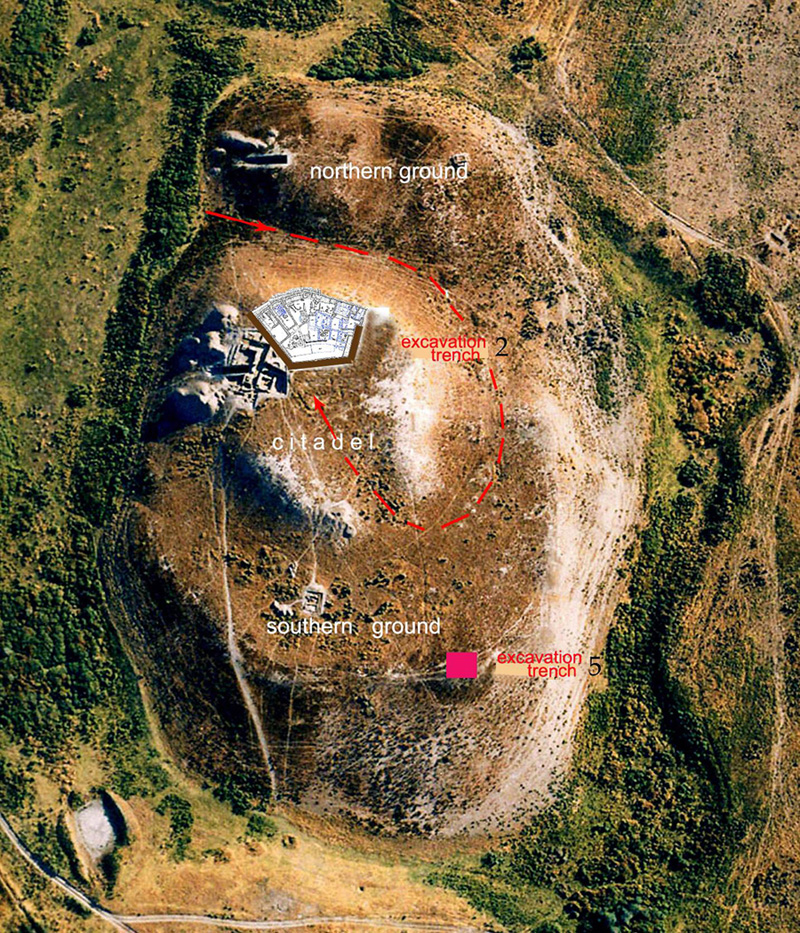
Fig. 2. Air photo of Sidak citadel (2006).
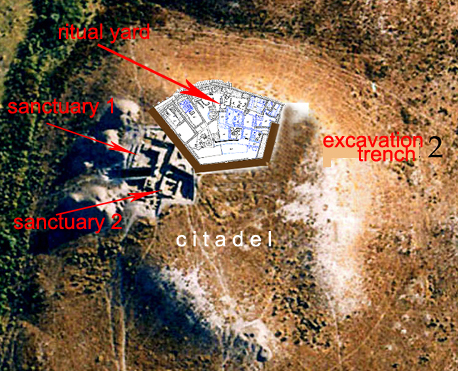
Fig. 3. South wall of ritual courtyard (to the left). Visit of the group
of Kazakhstan’ archaeologists (2005).
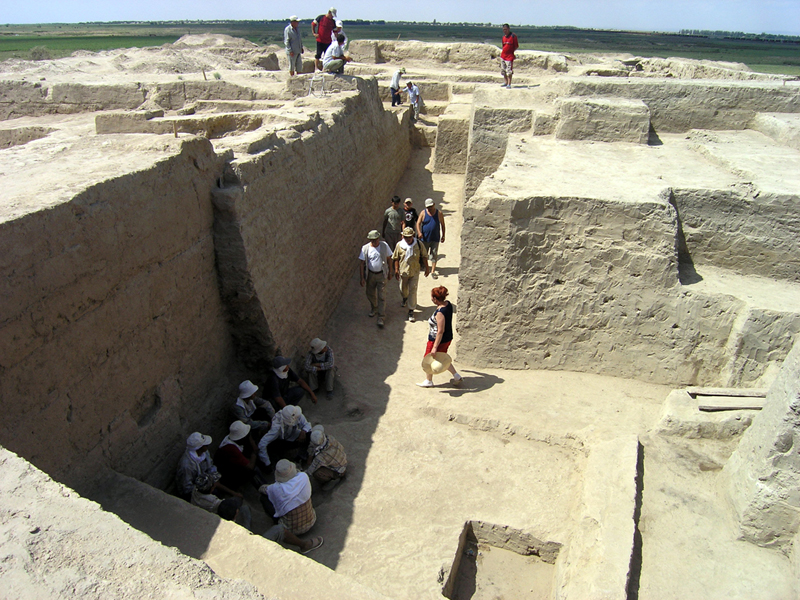
Fig. 4. Sufa in the south-east corner of ritual yard (2005).
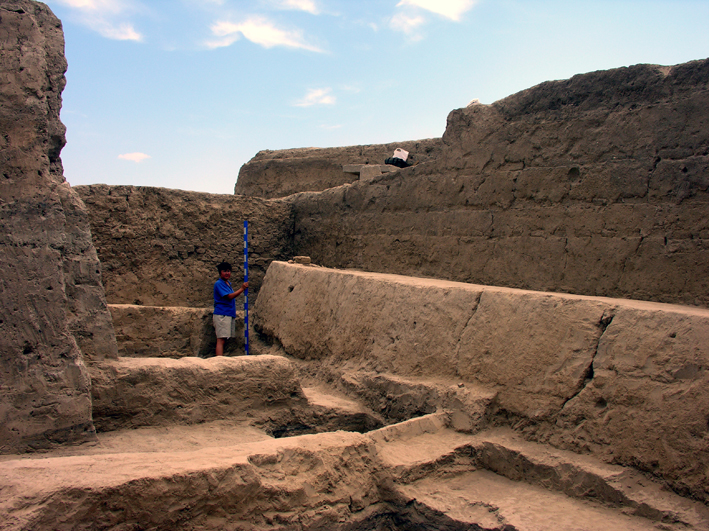
Fig. 5. Votive complex (“hoard”) from a jar, July 2006.
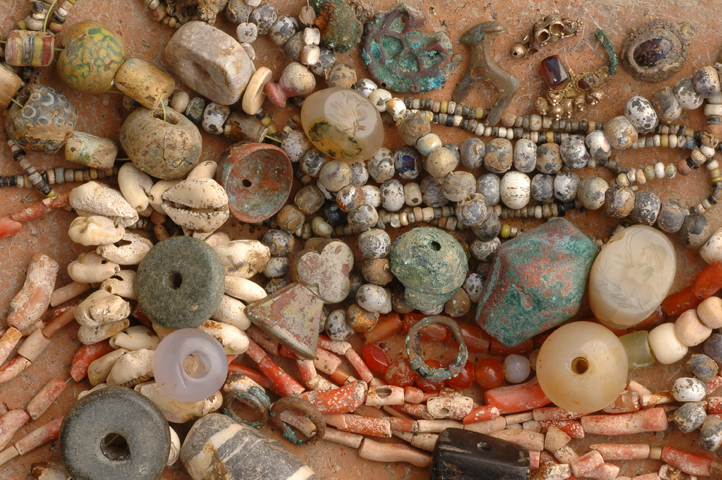
Fig. 6. Some details of 2006 votive complex.
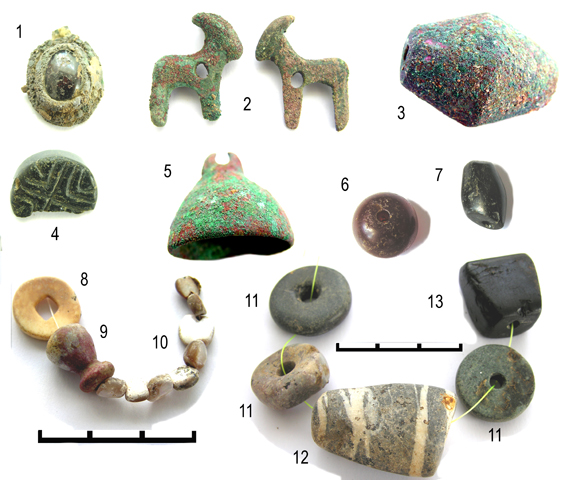
Fig. 7. Sasanid chalcedony seals in 2006 votive complex.
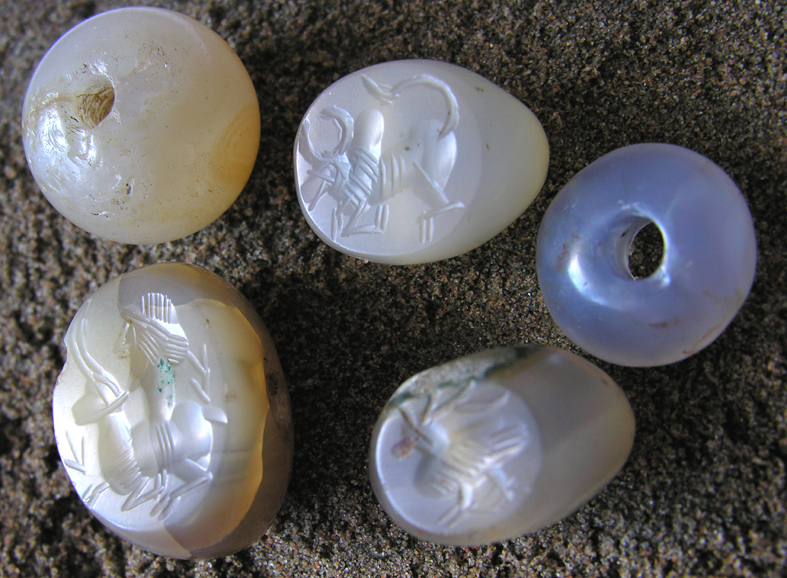
Fig. 8. Bronze amulets (goats’ figures) of 2006 votive complex.
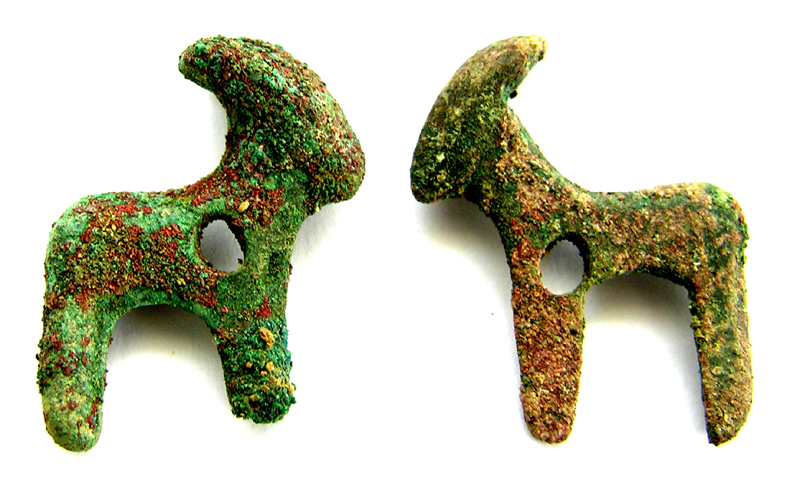
Fig. 9. Clay idol.
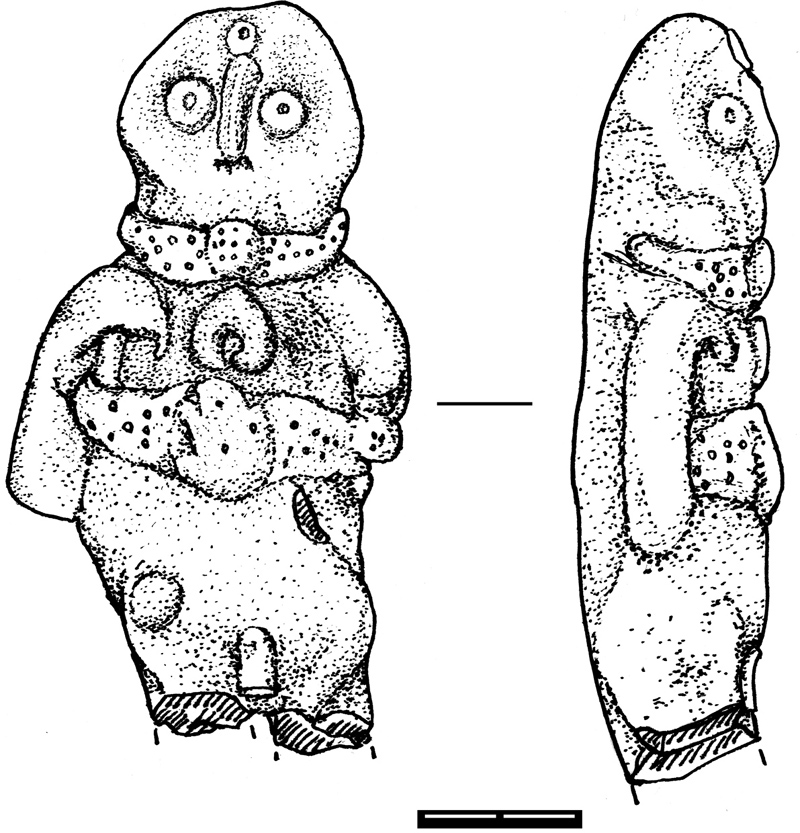
Fig. 10. Clay idol (photo).
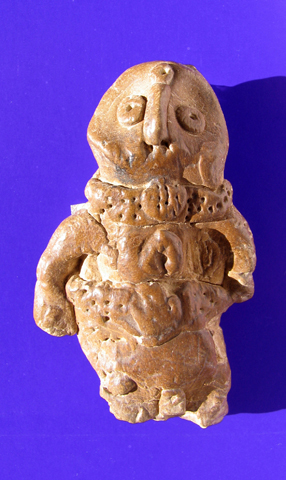
Fig. 11. Clay figure of bird.
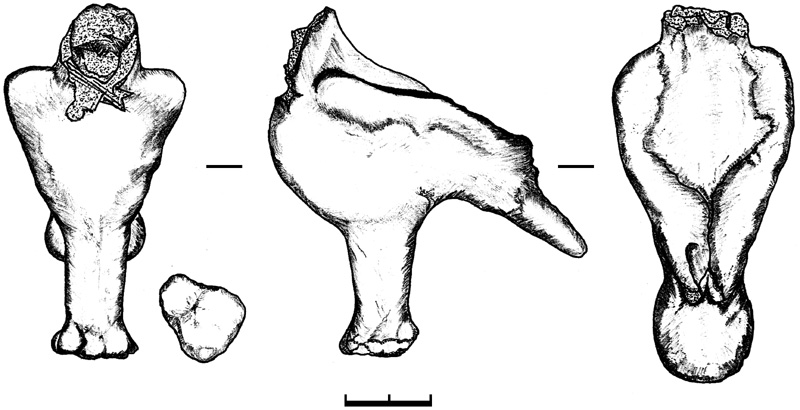
Fig. 12. Zoomorphic ritual incense cup (fragment).
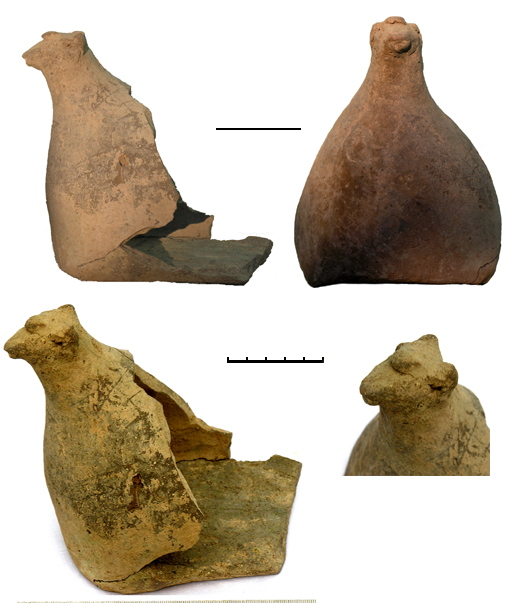
Fig. 13. Nishan/tamga-signs of Sidak: 1-60 – the mane types; 61-66 – groups of signs.
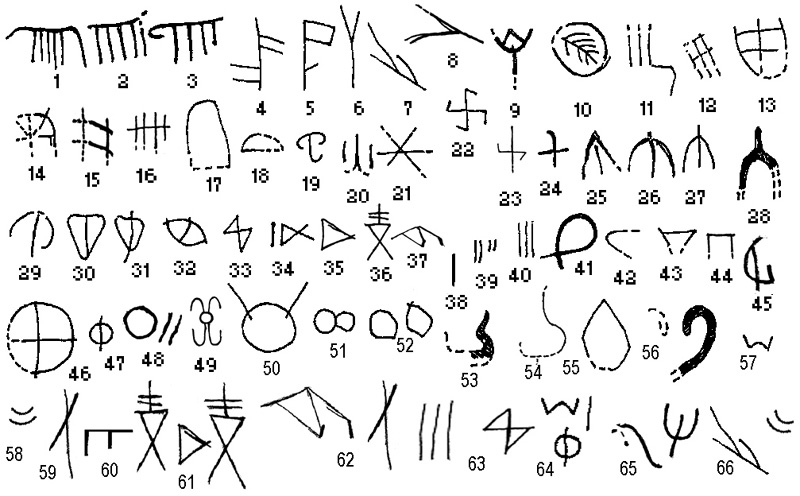
Fig. 14. Gala (“printed”) forms of Sidak’ nishan/tamga signs.
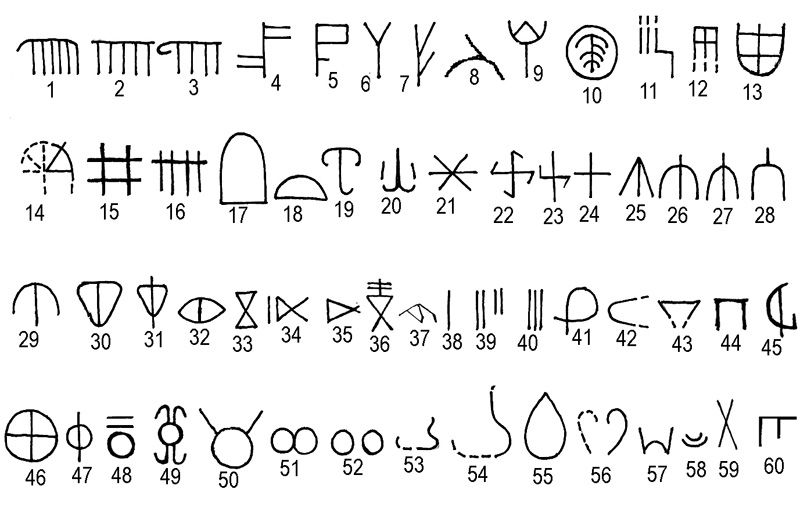
Fig. 15. Signs and pictures on the dices (stragalos/asyk) of Sidak.
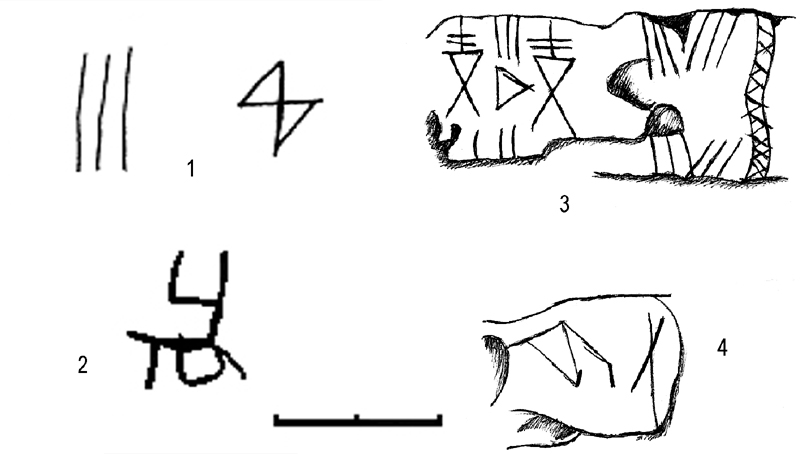
Fig. 16. Images from Sidak pottery.
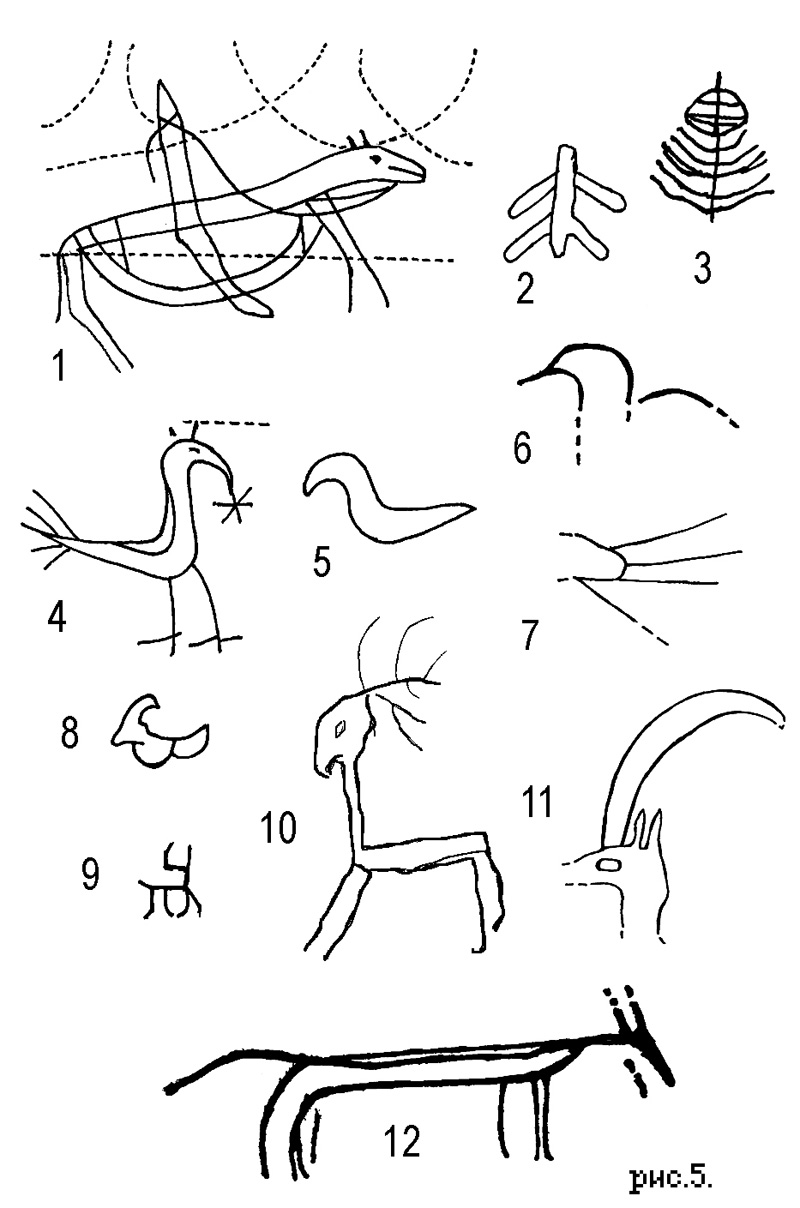
Fig. 17. 1 - “Bird and fish” subject on the hum, 2000; analogies of
“nishan-sign” on the bird’ head: 2 – mirror from grave 1 of Sidak
necropolis; 3 – “Sauromatian” cauldron from the museum in Aral’sk.
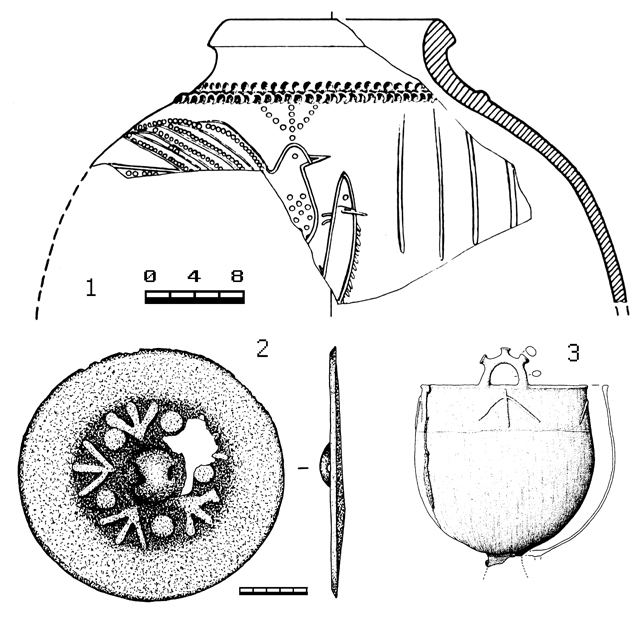
1. In the legendary written genealogy khoji of South Kazakhstan it is stated that Arabic forces came to the Middle Syrdarya region in 718-767 (Muminov 2005, 138-140).
2. The use of wooden boards under column bases was a wide spread technique in the architecture of Transoxiana in the Early Middle Ages. It was found in the temple hall of Mayda-tepe fortress (the 6th-7th cc.) in Ferghana (Brykina 1973, 122-123) and in the Buddhist temple in Kayalyk (Baipakov and all., 1999, 14).
3. The use of wooden boards under column bases was a wide spread technique in the architecture of Transoxiana in the Early Middle Ages. It was found in the temple hall of Mayda-tepe fortress (the 6th-7th cc.) in Ferghana (Brykina 1973, 122-123) and in the Buddhist temple in Kayalyk (Baipakov and all., 1999, 14).
4. The type of building signs on adobes is simple and the variants are not numerous. It does not have exact analogies with signs presented on ceramic pottery but sometimes is seen on dice-astragalos (fig. 15, 38-59).Circles, arches, lengthwise lines (from one to three), slantwise crosses, fingerprints of two fingertips. Signs of that type are widespread due to their simplicity, which proves the prevailing opinion: they were used to mark adobe lots made by this or that group of workers.
5. Four such Sasanid seals of chalcedony and cornelian in the form of signet ring included in a necklace were discovered on the breast of the woman in grave 55 in neighboring necropolis of Konyrtobe I. It cannot be excluded that such wares got to the region in the 5th–6th cc. as a result of wars between Iran and Heptalites (Baipakov, Smagulov, Erxhigitova 2005, 29, 45-49; fig. 1.32/1-4).
6. For example, in immediate neighborhood of premises 8/2005, (where the potter’s wheel was discovered) a cleared part of the yard was covered with a thick layer of hard baked clay (the area of 2.4 x 2.8 m) with pebble inclusion. But it is impossible to consider this ground in the center of the dwelling block being the place of large thick-sided vessels baking because of technological specificity and fire danger.
7. According to A.I. Naymark’s information Asbar coin imitations were in circulation up to the middle of the next 6th c. and then in the 7th c.
Al’baum L.I., 1975. Painting of Afrasiab (Zhivopis’ Afrasiaba). Tashkent.
Baipakov K.M., 1986. Medieval City Culture of South Kazakhstan and Jetysu (the 6th –the beg. of the 13th cc.) Srednevekovaya gorodskaya kul’tura Yuzhnogo Kazakhstana i Semirech’ya (VI – nachalo XIII vv.). Alma-Ata.
Baipakov K.M. and all., 1999. Archaeological Researches of the South Kazakhstan Complex’ Archaeological Expedition (Archeologicheskie issledovaniya Yuzhno-Kazakhstanskoy kompleksnoy arkheologicheskoy expeditsii) – Ministry of Science and High Education Herald (Vestnik Ministerstva nauki i vysshego obrazovaniya), Social sciences, 1999/1.
Baipakov K.M., Smagulov E.A., Erzhigitova A.A., 2005. Early Medieval Necropolises of the South Kazakhstan (Rannesrednevekovye nekropoli Yuzhnogo Kazakhstana). Almaty.
Baypakov K.M., Mar’yashev A.N., Potapov S.A., Goryachev A.A., 2005. Petroglyphs in Eshkiol’mes Mountains (Prtroglify v gorakh Eshkiol’mes). Almaty.
Bernshtam A.N. 1950. Problems of the Ancient History and Ethnic Development of South Kazakhstan (Problemy drevney istorii i etnogeneza Yuzhnogo Kazakhstana) - Proceedings of the Academy of Sciences of Kazakh Soviet Socialist Republic (Izvestiya Akademii Nauk Kazakhskoy SSR). Archaeology, 67/2. Alma-Ata.
Brykina G.A., 1973. Mayda-tepe Ancient Fortress (Gorodishche Mayda-tepe) - Short Reports of the Institute of Archaeology, Academy of Sciences of the USSR (Kratkie soobshcheniya Instituta archeologii AN SSSR), 136, Moscow.
Burnasheva R.Z., 1989. Otrar, Otrar Oasis and South Kazakhstan. Numicmatic Studies on Finances of the South Kazakhstan Cities of the 7th-17th cc. (Otrar, Otrarskiy osis i Yuzhniy Kazakhstan. Numizmaticheskie issledovaniya po denezhnomu khozyaystvu yuzhnokazakhstanskikh gorodov VII-XVII vv.). Alma-Ata.
Buryakov Yu.F., 1982. Origin and the Stages of City Culture Develpoment of Tashkent Oasis (Genezis i etapy razvitiya gorodskoy kul’tury Tashkentskogo oazisa). Tashkent.
Gorbunova N.G., 1999. Once more on Kara-Bulak Cemetery (Eshche raz o Kara-Bulakskom mogol’nike) - New on Ancient and Medieval Kyrgyzstan (Novoe o drevnem i srednevekovom Kyrgyzstane). Bishkek.
Gurevitch L.V., 1990. On Interpretation of Penjikent “Chapels” (K interpretatsii penjikentskih “kapell”) – Cultural Communications of the Peoples of Central Asia and Caucasus (Kul’turnye svyazi narodov Sredney Azii i Kavkaza) (Ed. by B.A. Litvinski). Moscow.
Filanovitch M.I., 1983. Tashkent. Origin and Development of the City Culture (Tashkent. Zarozhdenie i razvitie gorodskoy kul’tury). Tashkent.
Levina L.M., 1996. Ethnic and Cultural History of the East Aral Sea Region (Etnokul’turnaya istoriya Vostochnogo Priaral’ya). Moscow.
Meshkeris V.A., 1989. Sogdian Terracotta (Sogdiyskaya terracota). Dushanbe.
Most Ancient States of the Causacus and Central Asia, 1985 (Drevneyshie gosudarstva Kavkaza i Sredney Azii) (Ed. by G.A. Koshelenko). Moscow.
Muminov A.K., 2005. Kokand’ Version of Turkestan Islamization (Kokandskaya versiya islamizatsii Turkestana) – Hermits of Islam. Cult of Saints and Sufism in Transoxiana and on the Caucasus (Podvizhniki islama. Kul’t svyatykh i sufizm v Sredney Azii i na Kavkaze) (Ed. by S.N. Abashin, V.O. Bobrovnikov). Moscow.
Nerazik E.E., 1963. Excavations of Yakke-Parsan (Raskopki Yakke-Parsana) – Materials of Chorasmian Expedition, 7. Field excavations of Chorasmian Expedition in 1958-1961 (Materialy Khorezmskoy expeditsii, 7. Polevye issledovaniya Khorezmskoy expeditsii v 1958-1961 gg.). Moscow.
Raevsky D.S., 2001. Scythian Animal Style: Poetics and Pragmatics (Skifskiy zverinyi stil’: poetika i pragmatika) – Ancient Civilizations of Eyrasia. History and Culture (Drevnie tsivilizatsii Evrazii. Istoriya i kul’tura). Moscow.
Shagalov V.D., Kuznetsov A.V., 2006. Catalogue of the Coins of Chach. The 3rd – the 8th cc. AD. Tashkent.
Sher Ya.A., 1980. Petroglyphs of Transoxiana and Central Asia (Petroglify Sredney i Tsentral’noy Azii). Moscow.
Smagulov E.A., 2001. Amulets Complet Sets from the Graves of Necropolis of Kanyrtobe Ancient Fortress in Otrar Oasis (Amuletnye nabory iz pogrebeniy nekropolya gorodishcha Konyrtobe v Otrarskom oazise) – History of the Material Culture of Uzbekistan (Istoriya material’noy kul’tury Uzbekistana). Vol. 32. Tashkent.
Smagulov E., Tuyakbaev M. 2003. Archaeological excavations of Sidak ancient fortress (Arkheologicheskie issledovaniya gorodishcha Sidak) - Proceedings of the National Academy of Sciences of Kazakhstan Republic (Izvestiya Natsional’noy Akademii Nauk Respubliki Kazakhstan). Social Sciences. 2003/1.
Smagulov E.A., 2004a. Arab Invasion in South Kazakhstan: Evidence of the Written and Archaeological Sources (Arabskoe nashestvie v Yuzhnyi Kazakstan: dannye pis’mennykh i arkheologicheskikh istochnikov) - Mobilized by Archaeology (Mobilizovanniy arkheologiey)(Ed. by M.K. Khabdulina, D.A. Taleev, A.S. Ganieva). Astana.
Smagulov E.A., 2004b. “Shashlyk-braziers” of Altyntobe (“Shashlychnitsy” Altyntobe) - Proceedings of the Ministry of Education and Science, National Academy of Sciences of Kazakhstan Republic (Izvestiya Ministerstva obrazovaniya i nauki, Natsional’noy Akademii Nauk Respubliki Kazakhstan). Social Sciences. 2004/1
Smagulov E.A., Erzhigitova A.A., 2004. Grave Constructions of Sidak Necropolis (Pogrebal’nye sooruzheniya nekropolya Sidak) - Proceedings of the Ministry of Education and Science, National Academy of Sciences of Kazakhstan Republic (Izvestiya Ministerstva obrazovaniya i nauki, Natsional’noy Akademii Nauk Respubliki Kazakhstan). Social Sciences. 2004/1.
Smaguov E.A., Yatsenko S.A., 2006. Signs and Pictures on the Pottery from Sidak in Middle Syrdarya Region (Znaki i risunki na keramike Sidaka so Sredney Syrdar’i) – Turan-Turkestan: problems of the cultural and historic succession. The Proceedings of the International Conference devoted to the 10th anniversary of Turkestan archaeological expedition (Turan-Turkestan: problemy kul’turno-istoricheskoy preemstvennosti. Materialy mezhdunarodnoy nauchnoy konferentsii, posvyashchennoy 10-letiyu deyatel’nosti Turkestanskoy arkheologicheskoy expeditsii) (Ed. by T. Ryskeldiev). Turkestan.
Smirnova O.I., 1981. Complete Cataloque of the Sogdian Coins. Bronze (Svodniy katalog sogdiyskikh monet. Bronza). Moscow.
Tuyakbaev M., 2005. Stratigraphy of Sidak Ata Ancient Fortress (Stratifrafiya gorodishcha Sidak Ata) – Cultural Heritage of Kazakhstan: Discoveries, Problems, Perspectives. Proceedings of the International Conference (Kul’turnoe nasledie Kazakhstana: otkrytiya, problemy, perspektivy. Materialy mezhdunarodnoy nauchnoy konferentsii). Almaty.
Vainberg B.I., 1977. Coins of the Ancient Chorasmia (Monety drevnego Khorezma). Moscow.
Yatsenko S.A., 2000. Anthropomorphic Images in the Art of the Iranian-Speaking Peoples of Sarmatia of the 2nd-1st cc. BC. (Antropomorfnye obrazy v iskusstve iranoyazychnyh narodov Sarmatii II-I vv. do n.e.) – Stratum plus. 2000/4. St.-Petersburg-Kishinev.
Yatsenko S.A., 2001. Tamga-Signs of the Iranian Peoples in the Ancient Times and Early Middle Ages (Znaki-tamgi iranoyazychnikh narodov drevnosty i rannego srednevekov'ya). Moscow.
Yatsenko S.A., 2006a. Costume of the Ancient Eurasia (the Iranian-Speaking Peoples) (Kostyum drevney Evrazii [iranoyazychnye narody]). Moscow.
Yatsenko S.A., 2006b. Costume of Jetyasar Culture Against a Background of the Neighboring Peoples (Kostyum jetyasarskoy kul’tury na fone sosednikh narodov) – Turan-Turkestan: problems of the cultural and historic succession. The Proceedings of the International Conference devoted to the 10th anniversary of Turkestan archaeological expedition (Turan-Turkestan: problemy kul’turno-istoricheskoy preemstvennosti. Materialy mezhdunarodnoy nauchnoy konferentsii, posvyashchennoy 10-letiyu deyatel’nosti Turkestanskoy arkheologicheskoy expeditsii) (Ed. by T. Ryskeldiev). Turkestan.
Zeimal’ E.V., 1994. The Circulation of Coins of Central Asia during the Early Medieval Period (Fifth-Eighth Centuries AD) - Bulletin of the Asia Institute (New Series). Vol. 8. Bloomfield Hills.
Institute of Archaeology, National Academy of Science of Kazakhstan, Almaty, Kazakhstan.
e-mail: azret_sultan@mail.ru
Work address: Dr. Erbulat A. Smagulov, Institute of Archaeology, 44, Dostyk av., Almaty, 050028, Kazakhstan.
Russian State University for the Humanities, Moscow, Russia.
e-mail: sergey_yatsenko@mail.ru
Home address: Prof. Sergey A. Yatsenko, 5-1-66, Sayanskaya ul., Moscow, 111531, Russia.
 © The Author(s) -- Los artículos son propiedad de sus autores. (Ley 11.723 de la Republica Argentina)
© The Author(s) -- Los artículos son propiedad de sus autores. (Ley 11.723 de la Republica Argentina)